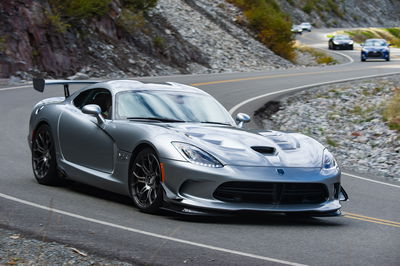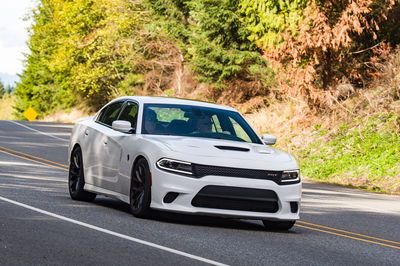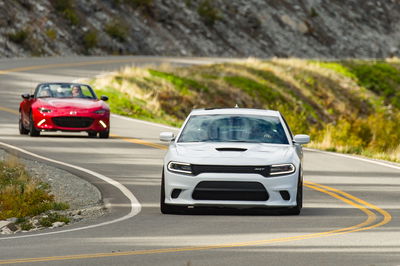Engineering Explained: 6 Reasons Why I'd Buy A Hellcat Over A Viper

1. Everyone Can Drive A Hellcat

It’s true. Unless you’re flooring it, driving a Hellcat is just like driving any other large sedan. It’s comfortable, quiet, and requires little effort. The backseats will become cluttered with trash. Your kids will scream and complain. You’ll get honked at the second the light turns green. That is, until you put your foot down. Not every other sedan has 707 horsepower. And there’s traction control for those who aren’t ready for their first burnout, regardless of the speed they’re travelling.
The Viper isn’t quite as carefree. The moment you sit in it, you feel like you’re not good enough. That’s because you probably aren’t. Each horsepower only has a little over five pounds of mass to accelerate. The power-to-weight ratio easily ousts the Hellcat. With great power comes a high probably of traction issues, and in the wrong hands, the Viper is a beast unwilling to be tamed. I felt excited driving it, but even more anxious. Yes, it’s an incredible piece of engineering and can rival most supercars on the track, but it’s far less inviting than the Hellcat.
2. The Hellcat Sounds Better
The Hellcat has three audible modes (figuratively speaking). When you’re cruising, throttle lightly depressed, acoustic glass and weight-adding sound deadening allows for a comfortable, quiet interior for easy conversation. Give the pedal moderate pressure, and you’ll be enclosed in a chamber of supercharger whine. It sounds so good you’ll forget turbochargers are more efficient. Foot to the floor, and the experience gets violent, as it should. You’re slammed into your seat and your ears are overwhelmed by the roar of the exhaust as all 700 horses attempt to find traction.
It’s not nearly as pleasant in the Viper. There’s only one mode, and it’s loud. The exhausts exit the sides, just in front of the rear wheels, creating an audibly stifling experience. Although it sounds ferocious with your foot down, the drone is a bit overbearing as a cruiser. And there’s no supercharger. Oh that Hellcat whine…
3. Snake Eyes

Snakes have poor vision, and that’s why they use their tongues so much. It’s only fitting that the Viper has lousy visibility, though I found sticking my tongue out to be of no help. The forward visibility is incredibly narrow, and adding to the complication is the fact that the hood stretches endlessly ahead. To the sides and out the back isn’t much better; it’s narrow all the way around. Perhaps suitable for hot lap sessions, but it makes it much more challenging to drive on the street. The Charger Hellcat has Charger visibility. It’s nothing exceptional, but it’s perfectly adequate for a full size sedan.
4. Buy One Get One Free

At nearly half the price, my point isn’t that you should buy a Hellcat simply because it’s cheaper. Of course it’s cheaper…it’s also a far less capable car. But the smiles per dollar ratio favours the Hellcat. It’s unreal that these cars started at just over $62,000 for their first model year (of course the dealers gouged consumers on this). When it was initially released, Dodge claimed this car to be the quickest (acceleration), fastest (top speed), and most powerful production sedan on the market. Tesla’s ludicrous mode appears to take away the quickest claim, but the point remains. As far as speed is concerned, the amount of g-forces you’re acquiring on a relatively feasible budget is staggering. Better yet, it’s covered under a five-year/100,000-mile warranty! Now yes, the Charger is a heavy boat and similarly priced vehicles can handle it on a track, but when you buy a 4600lb car, don’t be expecting to break lap records.
5. An Automatic Transmission?

Your human eyes do not fool you. Okay, they do a little bit. I’m not saying I’d rather have an automatic transmission over a manual (this is the only option in the Charger, so you’ll have to get the Challenger if you want to row your own cogs). I’d never say that, particularly with traditional planetary automatics. If there’s a manual available, it will be the box I’m ticking. Changing gears is a fun and involving experience that enhances the joy from driving vehicles.
But you don’t have to change gears in the Viper, and that’s disappointing. First gear will take you close to 60 miles per hour, and second gear will put you well over 80. For a car with enormous torque, yes, it makes sense to use tall gearing to tame it and make the power useable, but any time you’re on your favorite mountain road you’ll find that you never need to leave second gear. It’s a bit disappointing, because it’s almost no different than just driving an automatic. Of all the cars I’ve driven which have tall gearing, I feel the Viper is probably one of the most justified to do so, but that doesn’t make me love it.
6. Better Fuel Economy

The Charger Hellcat weighs over 1000lbs (approx 450kg) more than the Viper, has 62 more horsepower, and yet achieves 8.3 per cent better fuel economy in the city. Relax, I’m only kidding. There’s nothing impressive about 13mpg, nor the gas guzzler tax associated with both cars.
Happy Hellcatting!













Comments
No comments found.